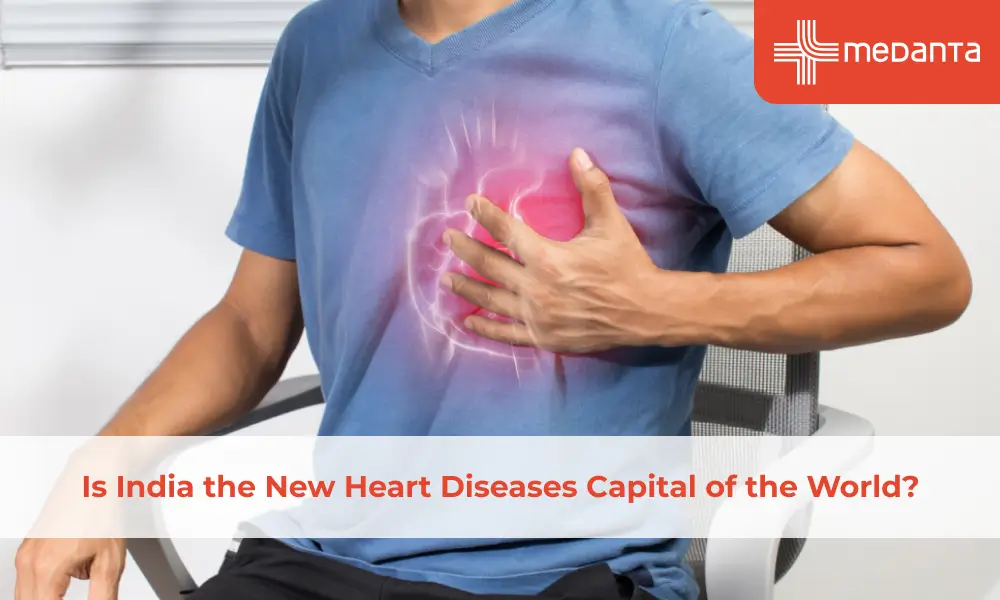Is India the New Heart Diseases Capital of the World?

TABLE OF CONTENTS
Introduction
Cardiovascular diseases (CVDs) include coronary heart disease, cerebrovascular illness, peripheral arterial disease, rheumatic heart disease, congenital heart defects, deep vein thrombosis, and pulmonary embolism, among other conditions affecting the heart and blood vessels.
In 2016, 17.9 million deaths worldwide were attributed to CVDs, or 31% of all fatalities. Deaths resulting from heart attack and stroke accounted for 85% of these fatalities. In low- and middle-income nations, where high blood pressure is one of the most significant risk factors for CVDs, more than 75% of CVD-related fatalities occur.
India recorded 63% of all NCD-related fatalities in 2016, with 27% of those deaths linked to CVDs. Additionally, 45% of fatalities in those aged 40 to 69 are caused by CVDs.
Being overweight and obese are risk factors for CVD, as are high blood pressure, high glucose, and high cholesterol levels. Premature deaths can be avoided by identifying people at risk for CVDs and ensuring they receive the proper care. To guarantee that truly needy people receive treatment and counseling, access to basic healthcare technology and important NCD medications is necessary for all primary healthcare institutions.
Determinants of Heart Diseases
Although CVD lifestyle factors are pervasive throughout India, there are notable regional and intra-regional differences. While hypertension seems to be more common in the north-eastern regions of India, diabetes mellitus seems to be more common in the southern states.
It's important to comprehend the social determinants of this heterogeneity, even though it can be attributed to cultural diversity, which results in different eating habits, cigarette use, physical exercise patterns, and different versions of economic growth within and between different Indian states.
The impoverished in India are more prone to misdiagnosis and underestimation of CVD. Financially deprived CVD patients are less likely to obtain evidence-based therapies because medical care frequently requires significant out-of-pocket expenses.
Compared to those in the high-income group, people in the low-income group are burdened with high out-of-pocket expenses, greater rates of disastrous health spending, and distressed finance. As a result, households impacted by CVD with lower SES are more likely to experience financial hardship or incur catastrophic medical costs. In addition to being a characteristic of acute care, out-of-pocket expenses are also noticeable in chronic care.
Occurrence of Heart Diseases
In India, men are more likely than women to have sudden cardiac death. Men are more likely to experience heart attacks, heart failure, coronary artery disease, angina, and arrhythmias than women. Despite the seriousness of the hazards, both men and women are thought to have little knowledge of the early warning signals of a heart attack.
Women have a nihilistic approach towards heart disease and moreover, they have atypical symptoms. Heart disease is commonly associated with men when the topic is discussed. However, heart disease is one of the primary causes of death in women.
Most women are perplexed since the early indicators of a heart attack in women and associated risk factors differ from those in males. However, women may enhance their general cardiac health by being more aware of the typical heart disease signs.

Diagnosis of Heart Diseases
The very worst thing you could do when you suffer heart-related concerns is to ignore them, even though heart disorders have the potential to inflict much bodily harm. Dizziness, chest discomfort, nausea, and vomiting are symptoms that are readily mistaken for other illnesses, making an early diagnosis even more crucial.
In India, a variety of tests are utilized to identify cardiac disease. They consist of:
Electrocardiogram (ECG or EKG)
Holter monitoring
Echocardiogram
Stress test
Angiogram or catheterization of the heart
Cardiac computed tomography (CT) scan
Cardiovascular magnetic resonance imaging (MRI)
Measurement of cardiac markers
One of the most dangerous chronic conditions affecting both sexes is cardiovascular disease. Consequently, early detection of cardiac issues in both women and men can reduce the possibility of a heart attack and other heart-related issues.
Prevention
Moderate exercising often, maintaining a healthy weight, and avoiding tobacco use are some ways to prevent heart disease. Dietary health includes adopting a diet containing natural elements such as a plant-based diet.
You can also manage your diabetes, obtain a blood pressure reading, keep an eye on your triglycerides and cholesterol, stop smoking, and avoid drinking alcohol.
Amazing heart-healthy habits include eating a lot of fruits, vegetables, whole grains, legumes, and lean meat while limiting your consumption of sodium and sugar and avoiding processed carbs and saturated fats.
Conclusion
You can easily stop many heart ailments by making the lifestyle modifications mentioned above. Additionally, you should see a doctor if you encounter any heart attack symptoms. In the end, prevention is always preferable to treatment.
Remember five ‘S’ – Sugar, Systolic BP, Salt, Stress, Smoking.






